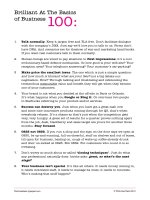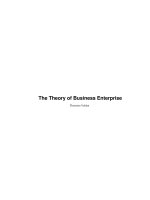Bloomberg Press 2005 Practice Made Perfect The Discipline of Business Management for Financial Ad_12 ppt
Bạn đang xem bản rút gọn của tài liệu. Xem và tải ngay bản đầy đủ của tài liệu tại đây (231.05 KB, 20 trang )
THE FOLLOWING performance evaluation illustrates how one company’s
value system (PILLAR) is linked to its performance-evaluation criteria. Be
sure that your evaluation questions are linked to your own company’s busi-
ness strategy and unique value system.
Name:
Date:
Position:
Office:
The purpose of self-evaluation is to:
! Assess your strengths and the areas you
feel need development
! List accomplishments for evaluating
advancement opportunities
! Generate ideas for discussion with
your performance coach
PASSION FOR EXCELLENCE
Please list your strengths:
Please list the areas you would like to improve (identify at least two):
Please list your accomplishments during the evaluation period:
198
WORKSHEET 3
Self-Evaluation
THE PILLAR
Passion for Excellence
Integrity
Lifetime Learning
Leading by Example
A Balanced Life
Respect for Others
Passion for Excellence
Integrity
Lifetime Learning
Leading by Example
A Balanced Life
Respect for Others
INTEGRITY
Please comment on your commitment to the professional and ethical
standards of the profession:
Please comment on your willingness to address unethical or inappropriate
behavior on the part of clients and colleagues:
LIFETIME LEARNING
Please comment on the adequacy of the training (internal and external)
you have received in terms of developing your skills:
Please comment on other training you have sought or attained outside
of the training provided by our firm:
What additional or new responsibilities have you assumed since your last
evaluation?
What areas do you believe you should be emphasizing to further your
career-development goals?
LEADING BY EXAMPLE
Describe how you have acted as a role model or mentor to others in the
office or firm:
SELF-EVALUATION 199
Source: © Moss Adams LLP
200 APPENDIX
What would you suggest as a means of enhancing the firm’s spirit within
our office?
A BALANCED LIFE
The amount of overtime you worked was:
More than expected/desired
❏
As expected/desired ❏
Less than expected/desired ❏
Comments:
Please comment on the balance between your professional and personal
life:
RESPECT FOR OTHERS
Please comment on your working relationships with your colleagues and
the firm’s clients:
What other questions or areas would you like to address during your
evaluation session?
Source: © Moss Adams LLP
THE FOLLOWING performance evaluation illustrates how one company’s
value system (PILLAR) is linked to its performance-evaluation criteria. Be
sure that your evaluation questions are linked to your own company’s busi-
ness strategy and unique value system.
Evaluation of:
Evaluation period:
Position: Evaluator’s name:
Instructions: The purpose of performance evaluation is to acknowledge areas of
strong performance, provide reinforcement, and discuss areas for development.
Evaluators are encouraged to:
! Reinforce areas of strength by commending
good performance
! Identify areas needing development and
provide specific examples
! Establish a measurable goal for primary areas
of performance where improvement or
additional experience is needed
RATINGS: A rating of “good” should be given if a person is meeting the
expectations and job requirements for his or her level of experience and
is progressing at a normal rate of advancement.
Excellent Exceptional performance; consistently exceeds expec-
tations
Very good Frequently exceeds expectations
Good Meets expectations and fulfills all responsibilities
201
WORKSHEET 4
Performance Evaluation
for Professional Staff
THE PILLAR
Passion for Excellence
Integrity
Lifetime Learning
Leading by Example
A Balanced Life
Respect for Others
Passion for Excellence
Integrity
Lifetime Learning
Leading by Example
A Balanced Life
Respect for Others
202 APPENDIX
RATINGS: (continued)
Needs improvement Requires development; does not consistently meet
expectations
Unacceptable Performance is below the acceptable level
Not rated Not enough basis for evaluation or not applicable
PASSION FOR EXCELLENCE
Demonstrates enthusiasm and pride in the work she/he performs.
❏ Excellent ❏ Very good ❏ Good
❏ Needs improvement ❏ Unacceptable ❏ Not rated
Comments:
Completes projects accurately and within budget.
❏ Excellent ❏ Very good ❏ Good
❏ Needs improvement ❏ Unacceptable ❏ Not rated
Comments:
Solves technical problems effectively. Demonstrates objectivity and an
analytical ability. Demonstrates a solid base of technical knowledge.
❏ Excellent ❏ Very good ❏ Good
❏ Needs improvement ❏ Unacceptable ❏ Not rated
Comments:
Speaks and writes clearly and effectively.
❏ Excellent ❏ Very good ❏ Good
❏ Needs improvement ❏ Unacceptable ❏ Not rated
Comments:
Demonstrates good listening skills.
❏ Excellent ❏ Very good ❏ Good
❏ Needs improvement ❏ Unacceptable ❏ Not rated
Comments:
Source: © Moss Adams LLP
Meets client-service expectations. Provides ideas, recommendations, and
solutions to clients that improve results.
❏ Excellent ❏ Very good ❏ Good
❏ Needs improvement ❏ Unacceptable ❏ Not rated
Comments:
INTEGRITY
Demonstrates an interest in personal growth and expansion of his/her
knowledge base.
❏ Excellent ❏ Very good ❏ Good
❏ Needs improvement ❏ Unacceptable ❏ Not rated
Comments:
Displays objectivity, identifies important issues, asks relevant questions,
reaches sound conclusions, and considers the potential impact before rec-
ommending actions.
❏ Excellent ❏ Very good ❏ Good
❏ Needs improvement ❏ Unacceptable ❏ Not rated
Comments:
Demonstrates an understanding of our clients’ needs.
❏ Excellent ❏ Very good ❏ Good
❏ Needs improvement ❏ Unacceptable ❏ Not rated
Comments:
LIFETIME LEARNING
Continues to develop his/her talents, skills, and knowledge.
❏ Excellent ❏ Very good ❏ Good
❏ Needs improvement ❏ Unacceptable ❏ Not rated
Comments:
PERFORMANCE EVALUATION FOR PROFESSIONAL STAFF 203
204 APPENDIX
Uses technology tools and resources effectively to perform assignments.
❏ Excellent ❏ Very good ❏ Good
❏ Needs improvement ❏ Unacceptable ❏ Not rated
Comments:
LEADING BY EXAMPLE
Demonstrates a positive attitude toward company goals and contributes to
maintaining high morale in the office.
❏ Excellent ❏ Very good ❏ Good
❏ Needs improvement ❏ Unacceptable ❏ Not rated
Comments:
Takes responsibility for actions and accepts responsibility for mistakes.
❏ Excellent ❏ Very good ❏ Good
❏ Needs improvement ❏ Unacceptable ❏ Not rated
Comments:
Acts as a role model or mentor for others.
❏ Excellent ❏ Very good ❏ Good
❏ Needs improvement ❏ Unacceptable ❏ Not rated
Comments:
A BALANCED LIFE
Provides a positive example to others as a person who is able to balance
professional responsibilities while also maintaining balance in his/her
personal life.
❏ Excellent ❏ Very good ❏ Good
❏ Needs improvement ❏ Unacceptable ❏ Not rated
Comments:
Source: © Moss Adams LLP
RESPECT FOR OTHERS
Treats colleagues with respect and consideration.
❏ Excellent ❏ Very good ❏ Good
❏ Needs improvement ❏ Unacceptable ❏ Not rated
Comments:
Keeps managers informed of progress and job status.
❏ Excellent ❏ Very good ❏ Good
❏ Needs improvement ❏ Unacceptable ❏ Not rated
Comments:
Responds to suggestions and input from others in a respectful manner.
❏ Excellent ❏ Very good ❏ Good
❏ Needs improvement ❏ Unacceptable ❏ Not rated
Comments:
PERSONNEL MANAGEMENT
Demonstrates a commitment to the development of other people in the
office.
❏ Excellent ❏ Very good ❏ Good
❏ Needs improvement ❏ Unacceptable ❏ Not rated
Comments:
Conducts performance reviews that are comprehensive, productive, and
timely.
❏ Excellent ❏ Very good ❏ Good
❏ Needs improvement ❏ Unacceptable ❏ Not rated
Comments:
PERFORMANCE EVALUATION FOR PROFESSIONAL STAFF 205
206 APPENDIX
Recognizes staff members for good performance and coaches them when
improvement is needed.
❏ Excellent ❏ Very good ❏ Good
❏ Needs improvement ❏ Unacceptable ❏ Not rated
Comments:
ENGAGEMENT MANAGEMENT
Plans and manages engagements to achieve efficiency and develop the skill
of staff members.
❏ Excellent ❏ Very good ❏ Good
❏ Needs improvement ❏ Unacceptable ❏ Not rated
Comments:
MARKETING AND PRACTICE DEVELOPMENT
Is actively involved in professional and community activities.
❏ Excellent ❏ Very good ❏ Good
❏ Needs improvement ❏ Unacceptable ❏ Not rated
Comments:
Initiates actions that create new client opportunities.
❏ Excellent ❏ Very good ❏ Good
❏ Needs improvement ❏ Unacceptable ❏ Not rated
Comments:
ADDITIONAL COMMENTS
OVERALL PERFORMANCE SUMMARY
In general, this individual is:
❏ Exceeding performance expectations and progressing rapidly
❏ Meeting performance expectations and progressing very well
❏ Meeting most performance expectations and progressing satisfactorily
❏ Meeting some performance expectations; needs improvement
❏ Currently not meeting performance expectations
Source: © Moss Adams LLP
PRIMARY STRENGTHS
What primary strengths were identified during the evaluation?
1.
2.
3.
AREAS FOR DEVELOPMENT
Identify key areas where improvement or additional experience is needed.
1.
2.
3.
Develop a goal for each key area for development.
1.
2.
3.
Staff member’s comments
SIGNATURES
I acknowledge that I have had an opportunity to discuss this evaluation with
my performance coach.
Staff Member Date
Evaluated by:
Performance Coach Date
Reviewed by:
Partner Date
PERFORMANCE EVALUATION FOR PROFESSIONAL STAFF 207
THE FOLLOWING performance evaluation illustrates how one company’s
value system (PILLAR) is linked to its performance-evaluation criteria. Be
sure that your evaluation questions are linked to your own company’s busi-
ness strategy and unique value system.
Evaluation of:
Evaluation period:
Your position:
❏ Client service
❏ Administrative staff
Instructions: The purpose of performance evaluation is to acknowledge
areas of strong performance, provide reinforcement, and discuss areas for
development.
Evaluators are encouraged to:
! Reinforce areas of strength by
commending good performance
! Identify areas needing development and
provide specific examples
! Establish a measurable goal for
primary areas of performance where
improvement or additional experience is
needed
During my work with this individual, I have found that he or she (please
comment in each area):
208
WORKSHEET 5
Upstream Evaluation
THE PILLAR
Passion for Excellence
Integrity
Lifetime Learning
Leading by Example
A Balanced Life
Respect for Others
Passion for Excellence
Integrity
Lifetime Learning
Leading by Example
A Balanced Life
Respect for Others
Source: © Moss Adams LLP
PASSION FOR EXCELLENCE
Is technically proficient, provides good advice, and is able to answer my
technical questions.
❏ Consistently ❏ Usually ❏ Sometimes ❏ Rarely ❏ Not rated
Evaluator’s comments:
Demonstrates a passion for excellence in his or her work.
❏ Consistently ❏ Usually ❏ Sometimes ❏ Rarely ❏ Not rated
Evaluator’s comments:
Provides noticeably superior service to our clients.
❏ Consistently ❏ Usually ❏ Sometimes ❏ Rarely ❏ Not rated
Evaluator’s comments:
INTEGRITY
Recognizes the full range of our clients’ needs and recommends value-
added services that improve their business results.
❏ Often ❏ Occasionally ❏ Seldom ❏ Never ❏ Not rated
Evaluator’s comments:
Delegates challenging work that is appropriate for my level of experience.
❏ Delegates work appropriately
❏ Delegates assignments that are too easy
❏ Delegates assignments that are too difficult
❏ Not rated
Evaluator’s comments:
Includes me in meetings with clients.
❏ Often ❏ Occasionally ❏ Seldom ❏ Never ❏ Not rated
Evaluator’s comments:
UPSTREAM EVALUATION 209
210 APPENDIX
LIFETIME LEARNING
Helps me to develop my skills by providing opportunities for growth and
challenge.
❏ Often ❏ Occasionally ❏ Seldom ❏ Never ❏ Not rated
Evaluator’s comments:
LEADING BY EXAMPLE
Conducts productive and timely performance evaluation meetings. (Please
check “Not rated” if this person is not responsible for giving you written
evaluations.)
❏ Consistently ❏ Usually ❏ Sometimes ❏ Rarely ❏ Not rated
Evaluator’s comments:
Makes time to be accessible when I have suggestions, questions, or prob-
lems.
❏ Consistently ❏ Usually ❏ Sometimes ❏ Rarely ❏ Not rated
Evaluator’s comments:
Listens attentively and is interested in my opinions and thoughts.
❏ Listens intently ❏ Is usually attentive
❏ Often does not hear what I am saying ❏ Not rated
Evaluator’s comments:
Gives me recognition for my contributions and efforts.
❏ Often ❏ Occasionally ❏ Seldom ❏ Never ❏ Not rated
Evaluator’s comments:
A BALANCED LIFE
Understands that it is important for staff members to maintain balance in
our lives.
Source: © Moss Adams LLP
❏ Consistently ❏ Usually ❏ Sometimes ❏ Rarely ❏ Not rated
Evaluator’s comments:
RESPECT FOR OTHERS
Treats people with respect.
❏ Consistently ❏ Usually ❏ Sometimes ❏ Rarely ❏ Not rated
Evaluator’s comments:
What do you most like about working with this individual?
Do you have any suggestions for improving your working relationship?
UPSTREAM EVALUATION 211
THE FOLLOWING TABLE is an excerpt from the 2003 FPA Compensation
and Staffing Study. It illustrates how to interpret and use the data tables
the study provides for each job title. Whatever analysis or salary survey
you employ to review your business should consider the same questions
outlined here, so that you can be sure you’re using the data appropriately
and effectively.
212
WORKSHEET 6
How to Use Compensation Benchmarking
and Salary-Survey Data
PARAPLANNER
Primary Function K
A technical position responsible for the detail work in developing modular or compre-
hensive financial plans for clients in support of a relationship manager. Limited client
contact except in meetings, data gathering and follow-up.
Number of positions reported: 267
% who are owners: 0.4
Median % ownership: 25.0
<
$250,000
$250,000– $500,000–
>$1,000,000 $500,000 $1,000,000
Positions reported, by firm revenue 10.5% 13.9% 24.3% 51.3%
Salary + Commission Ownership
Salary Only Incentive Only Distribution Combination No Data
Compensation method 43.1% 45.7% 0.0% 0.0% 6.0% 5.2%
Lower Upper
Compensation information:
Quartile Median Quartile
Base compensation $32,500 $38,000 $45,759
% reporting bonus 48.9%
Bonus $1,309 $3,000 $5,043
Median bonus, % median salary 7.9%
% reporting commissions 4.9%
Commissions $5,000 $10,000 $21,000
% reporting ownership distribution 0.4%
Ownership distribution $670 $670 $670
Total compensation $35,000 $40,000 $50,000
Factors impacting compensation:
Variance as a % of median base compensation
Lower Upper
Quartile Median Quartile
Experience (in years) 3 5 8
Variance in salary by work experience 89% 105% 139%
Tenure (in years) 1 3 5.75
Variance in salary by tenure 105% 97% 123%
How many firms of similar size
employ someone in this role?
Start the discussion with
the median base salary.
Does the position
typically receive
a bonus?
What will the bonus be
in your organization?
How does it compare?
How will the total com-
pensation compare?
Source: © Moss Adams LLP
Based on the simple analysis described above, establish a range of base
compensation for the employee and then determine the final compensation
inside the range based on the characteristics of that individual.
PARAPLANNER (continued)
CFP
CFP certificate holder 14.6%
Variance in salary if CFP certificant 111%
$250,000–
Population of local market
<$250,000 $1,000,000 $1,000,000+ No Data
% of positions reported by population 18.4% 23.3% 54.3% 4.0%
Variance in salary by population 83% 95% 105%
Most common secondary functions
No Secondary O N, Q Other
% reporting secondary function 49.8% 13.1% 6.4% 30.7%
Variance in salary by secondary function
As a % of median base compensation
100% 101% 89%
As a % of total compensation
100% 106% 94%
Full- vs. part-time:
Full-Time Part-Time No Data
% of positions reported 83.5% 15.7% 0.7%
Lower Upper
Quartile Median Quartile
Annual salary for part-time $19,500 $25,000 $30,000
What impact does the location of your firm, the
employee’s level of experience, and his/her secondary
functions typically have on base pay for this position?
HOW TO USE COMPENSATION BENCHMARKING AND SALARY-SURVEY DATA 213
RECORD YOUR DOLLAR BALANCES in the dollars column ($). Remember
that total assets need to equal total liabilities and equity. Divide all dollar
balances by total assets to arrive at the percentages (%).
Dollars and Common Size
Percentages
($) (%)
1 Cash
2 Marketable securities
3 Accounts receivable—net
4 All other current assets
5 Total current assets
(sum 1 to 4)
6 Property
7 Furniture, fixtures, and equipment
8 Other fixed assets
9 Total gross fixed assets
(sum 6 to 8)
10 Less accumulated depreciation
11 Total net fixed assets
(9 minus 10)
12 Other long-term assets
13 Total assets
(sum 5, 11, and 12)
214
WORKSHEET 7
Balance Sheet
Source: © Moss Adams LLP
Dollars and Common Size
Percentages
($) (%)
LIABILITIES AND EQUITY
14 Notes payable
15 Taxes payable
16 Accounts payable
17 Accruals
18 Current portion of
long-term debt
19 All other current liabilities
20 Total current liabilities
(sum 14 to 19)
21 Long-term debt
22 Other noncurrent liabilities
23 Total long-term liabilities
(sum 21 and 22)
24 Total liabilities
(
sum 20 and 23)
25 Equity (net worth)
26 Total liabilities and equity
(sum 24 and 25)
BALANCE SHEET 215
RECORD YOUR DOLLAR EXPENSES in the dollars column ($). Divide all dollar
expenses by the total revenue to arrive at the percentages (%).
216
WORKSHEET 8
Income Statement
Dollar and Common Size
Percentages
($) (%)
1 Asset-management fees
2 Planning and consulting fees
3 Securities commissions—current
4 Securities trails
5 Insurance commissions
—new or first year
6 Insurance renewals
7 Other revenue
8 Total revenue (sum 1 to 8) 100%
9 Nonowner professional salaries
10 Commissions paid and other
direct expenses
11 Owners’ draws or base
compensation
12 Total direct expense
(sum 9, 10, 11)
13 Gross profit (8 minus 12)
14 Advertising, public relations,
and marketing
15 Auto expenses
16 Charitable contributions
Source: © Moss Adams LLP
Dollar and Common Size
Percentages
($) (%)
17 Client appreciation
18 Depreciation and amortization
19 Dues (clubs)
20 Dues (professional)
21 Employee benefits
22 Equipment leases and purchases
23 Insurance
24 Office expense
25 Other salaries
26 Payroll taxes
27 Professional services
28 Rent
29 Repairs and maintenance
30 Software and hardware expense
31 Tax and licenses
32 Training and continuing
education
33 Travel and entertainment
34 Utilities, phone, fax, and
online service
35 All other expenses
36 Total overhead (sum 14 to 35)
37 Operating profit (13 minus 36)
INCOME STATEMENT 217









